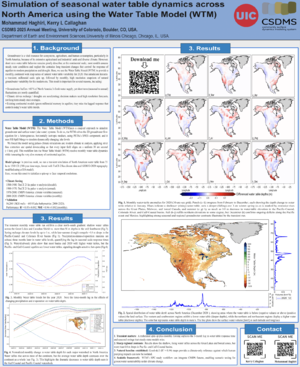2025 CSDMS meeting-026: Difference between revisions
From CSDMS
Created page with "{{CSDMS meeting personal information template-2025 |CSDMS meeting first name=Mohammad |CSDMS meeting last name=Haghiri |CSDMS meeting institute=University of Illinois Chicago |CSDMS meeting city=Chicago |CSDMS meeting country=United States |CSDMS meeting state=Illinois |CSDMS meeting email address=mhaghi2@uic.edu |CSDMS meeting phone=3126841375 }} {{CSDMS meeting select clinics1 2025 |CSDMS_meeting_select_clinics1_2025=3) An Introduction to GRASS GIS and Tangible Landsca..." |
No edit summary |
||
| (4 intermediate revisions by one other user not shown) | |||
| Line 19: | Line 19: | ||
}} | }} | ||
{{CSDMS meeting abstract yes no 2025 | {{CSDMS meeting abstract yes no 2025 | ||
|CSDMS meeting abstract submit 2025= | |CSDMS meeting abstract submit 2025=Yes | ||
}} | |||
{{CSDMS meeting abstract poster Epub 2025 | |||
|CSDMS meeting poster Epub submit 2025=Poster | |||
}} | |||
{{CSDMS meeting abstract title temp2025 | |||
|CSDMS meeting abstract title=Simulation of seasonal water table dynamics Across North America using the Water Table Model (WTM) | |||
|Working_group_member_WG_FRG=Hydrology Focus Research Group | |||
}} | |||
{{CSDMS meeting authors template | |||
|CSDMS meeting coauthor first name abstract=Kerry | |||
|CSDMS meeting coauthor last name abstract=Callaghan | |||
|CSDMS meeting coauthor institute / Organization=University of Illinois Chicago | |||
|CSDMS meeting coauthor town-city=Chicago | |||
|CSDMS meeting coauthor country=United States | |||
|State=Illinois | |||
|CSDMS meeting coauthor email address=kerryc@uic.edu | |||
}} | |||
{{CSDMS meeting abstract template 2025 | |||
|CSDMS meeting abstract=Understanding trends in water table dynamics is critical for closing the global water budget and for water resources management and environmental sustainability. Continental-scale hydrological simulations typically assume that the water table is at steady-state, despite the fact that this is unlikely to be true under changing climate. Here, we present monthly water table fields for the year 2020 across North America based on a simulation using the Water Table Model (WTM). To obtain these, we initialised the WTM using a transiently simulated water table from 500 years before present, and performed a model spin-up to obtain our monthly temporal resolution. The WTM integrates climate variables, topography, and hydrogeological characteristics to simulate depth to the water table, including groundwater and lakes. Our results offer insights into spatial and temporal patterns of water table response to seasonal climatic conditions. Results indicate significant regional variations in water table fluctuations driven by seasonal precipitation and evapotranspiration. This study shows a lag time of approximately 3 to 4 months between measured changes in climate variables and the corresponding response in the water table level. Our study emphasizes the need for targeted, regional management practices to mitigate potential adverse impacts and to optimize water resources under climatic changing conditions. | |||
|CSDMS meeting posterPDF= Poster_CSDMS6.pdf | |||
|CSDMS meeting posterPNG= Poster_CSDMS6.png | |||
}} | }} | ||
{{blank line template}} | {{blank line template}} | ||
Latest revision as of 06:35, 30 May 2025
(if you haven't already)
Log in (or create account for non-CSDMS members)
Forgot username? Search or email:CSDMSweb@colorado.edu
Browse abstracts
Simulation of seasonal water table dynamics Across North America using the Water Table Model (WTM)
Mohammad Haghiri,
University of Illinois Chicago Chicago Illinois, United States. mhaghi2@uic.edu
Kerry Callaghan, University of Illinois Chicago Chicago Illinois, United States. kerryc@uic.edu
Understanding trends in water table dynamics is critical for closing the global water budget and for water resources management and environmental sustainability. Continental-scale hydrological simulations typically assume that the water table is at steady-state, despite the fact that this is unlikely to be true under changing climate. Here, we present monthly water table fields for the year 2020 across North America based on a simulation using the Water Table Model (WTM). To obtain these, we initialised the WTM using a transiently simulated water table from 500 years before present, and performed a model spin-up to obtain our monthly temporal resolution. The WTM integrates climate variables, topography, and hydrogeological characteristics to simulate depth to the water table, including groundwater and lakes. Our results offer insights into spatial and temporal patterns of water table response to seasonal climatic conditions. Results indicate significant regional variations in water table fluctuations driven by seasonal precipitation and evapotranspiration. This study shows a lag time of approximately 3 to 4 months between measured changes in climate variables and the corresponding response in the water table level. Our study emphasizes the need for targeted, regional management practices to mitigate potential adverse impacts and to optimize water resources under climatic changing conditions.

